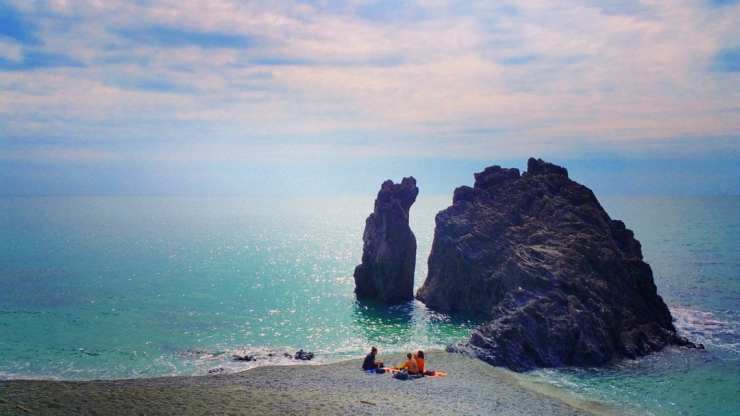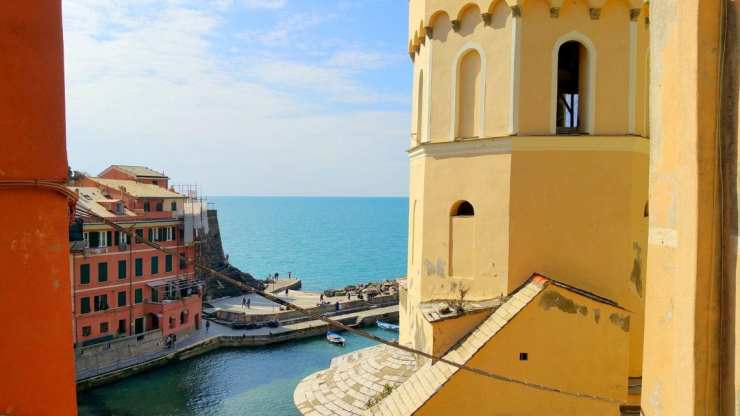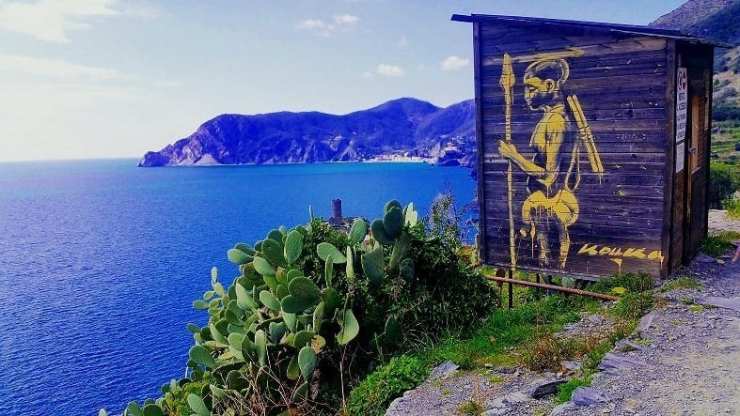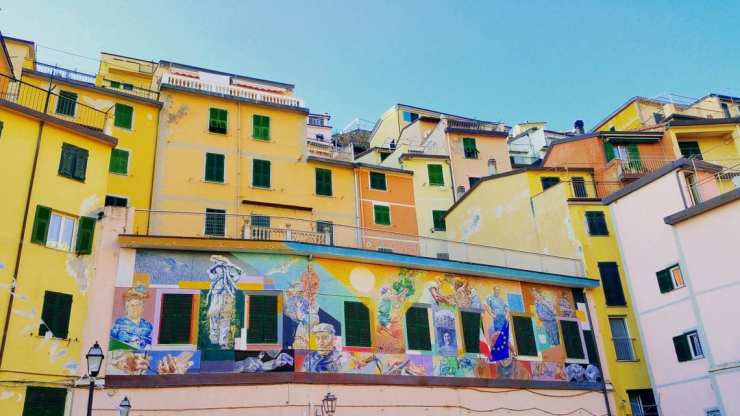This was a special hike. A solo climb along the Ligurian Sea that took my breath with the views and literally too with the hike that threatened to send my heart jumping out of my body. It started a few summers ago when we met up with a young cousin of my husband’s, a brilliant chap who had backpacked through the villages in the Liguria region in Italy. I was hooked by his stories. I had seen tantalising shots of the rugged landscape of the portion of the Italian Riviera which is the Cinque Terre (pronounced as Chink-weh Tay-rreh).
Cinque is ‘Five’ and Terre means ‘Lands’ in Italian, referring to the five villages of Monterosso al Mare, Vernazza, Corniglia, Manarola and Riomaggiore. They are part of the province of La Spezia.
Before my acquaintance with the Cinque Terre happened, I could barely manage to remember even the first half of Monterosso. Now, my friend, I can rattle off the names of the medieval villages – without a stutter. Cutting a trail through the stunning little hamlets is bound to imprint them into the grey cells.
At the start of this year’s spring, I sat on an intercity train from Milan for Monterosso al Mare, the oldest of the villages that was founded by hill dwellers in an effort to escape the invading Visigoths in AD 643. It was a long three-hour journey and in the company of two jocks and a trio of women in the train compartment, I slept in fits and starts. But my eyes shot open once the blue waters of the Ligurian Sea cropped up on the right and became a constant feature, only to be interspersed by ochre-hued Italian villas and multi-tiered brick red roofs.



The train passed by the city of La Spezia, capital of the eponymous province. I looked out with great longing. It seemed enticing even with just a glimpse and I quietly vowed to return to La Spezia in the summer months.
Stretching out my cramped legs at the small station in Monterosso, I figured from a map that I was in the westernmost (and largest village) of the Cinque Terre. My plan was to set out on the Sentiero Azzurro (Blue Trail) and hike my way from village to village. The five villages, deemed as part of a UNESCO World Heritage Site, lie within the Parco Nazionale delle Cinque Terre (National Park of the Cinque Terre).
This Blue Trail hugs craggy cliffs that skirt the coast line and is a paid-for hike but for some reason hikers could go free at the time. Before I started my hike, I stood on a pedestrian promenade facing the sandy stretch of Spiaggia di Fegina (beach of Fegina), part of the new town of Monterosso. Nibbling into a slice of warm spinach quiche, I questioned the reality of it all – the waters sparkling away like a million tiny diamonds in the morning sun, determined to hypnotise the onlooker.
Next I found myself in a dilemma. Did I have to turn left or take the path on my right hand side? I am terrible with directions (left alone in a desert or a forest with just a compass, I am positive I would never find my way back to civilisation) and even the GPS at moments fills me with misgivings.
A loquacious Italian led me to believe that there could only be one direction for the trail. I was indeed walking in the opposite direction. An about turn made, I set off in the direction of a medieval castle and a Capuchin monastery that are positioned above a cliff called San Cristoforo. Standing sentinel over the coast line, rather dramatically, is the statue of Neptune, or the Giant, as he is known by locals.
A gaggle of chirpy houses was clustered up charmingly, on my left, and sail boats tethered to the right, the sea immediately beyond. I was soon on the pedestrian path that led up to a hotel, which was my landmark for the beginning of the 11-km long Sentiero Azzurro.
The trail started off with gentle steps cutting a path through vineyards and orchards of lemon trees – oh yes, fat yellow lemons that called out to be culled (no, I did not dare give into the urge because my nerves, I fear, could not have taken on the wrath of a farmer if he caught me scrumping). Next came steep steps which must have numbered between 600 and 700. Even with my gymming genes in place, I was gasping for breath, my heart fit to explode. I stopped every five minutes. An own inner voice urged me, ‘Abandon this crazy scheme. Just take the train to the next village, will you?’



Soon came my way elderly couples who chirped out sunny ‘Buongiornos’ – must have been the fact that they were making their way downhill. I managed to gasp out my bit of goodwill and persevered in my uphill endeavour, seeing in my mind’s eye, giant cones of gelato waiting at the end of the trail. You have got to have some perspective in life.
The path became severely narrow and apparently would have been tread by mules and goats in the past. The trail took me through the heart of a beautiful landscape, past terraces cut into the cliffs, dotted with orchards, woods, tiny waterfalls, stone bridges and gushing brooks, in phases. I felt like George (you know sulky Georgina of our childhood Famous Five tales), except I was without my Timmy.
Often I would pass by farmers working on their crops, a cottage or two on the slopes with cheerful green and blue-hued doors, a lone old man standing with a pile of juicy oranges and selling fresh juice by the wayside, and even ‘orphan’ cats who had their own little homes and bowls and could do with some donation, thank you.
It took about an hour and fifteen minutes before I came upon a sight that is splashed all over postcards from the Cinque Terre. Lo and behold, the village of Vernazza, with its stack of tall and narrow pastel-hued houses, was nestled amongst the astonishingly jewel-like turquoise waters below. Edging past a group of extremely enthusiastic Oriental individuals who were frozen in various poses for photo and selfie sessions, I got my personal postcard shots. It was a bit of a self-congratulatory moment – for not turning my back on the hike and losing out on such undiluted moments of, natural and manmade, beauty.
Of all the five fishing villages of the Cinque Terre, my heart was captured by Vernazza. Charm lurks around its corners. The 12th century Chiesa di Santa Margherita d’Antiochia (Church of Santa Margherita), the fishermen’s cottages that hug each other and wind up and down narrow alleys, the harbour coloured up with fishermen’s boats and the 16th century tower that stands guard over the village (it once used to be a lookout for pirates) – these aspects of Vernazza fall together in place so naturally.


Life in Vernazza runs just as it would have in the old times, with the exception of the tourists trooping in. Fishermen still go about their business, clothes dry on lines spanning the facades of houses, piles of fishing nets dry in corners and century-old traditions of olive and lemon farming along with wine making continue undeterred.
Lunch in Vernazza, for me, was a humongous cone of gelato. I sat dangling my legs from the natural harbour and gave into the parade of colour around. The turquoise of the sea gave way to the vibrant yellow, orange and blue boats bobbing on the waves in the harbour. Pink, terracotta, yellow and beige shaded house fronts sported green window shutters. Colourful clothes on clotheslines fluttered in the wind. I had a most satisfying view as I walloped the gelato with relish. The kind of relish that can come only after a-few-painful-wheezes-and-then-some-more kind of a hike.
I could imagine the fortified Vernazza of the 1000s when it was supposed to have been a maritime base because of its natural harbour. It was ruled by the Italian noble family of Obertenghis and must have been a well-off village given the surviving architectural elements of arched loggias and arcades. The piazza I had walked through would not have been there in those times and neither would have been the breakwater that sits in the harbour today. Instead waves from the Ligurian Sea would have dashed against the houses on the rocks and boats would have been chained to the rocks.












A fair share of daydreaming and it was time for me to set off for the next leg of my hike to the village of Corniglia. Steep stone steps cut through houses and led to the woods. I was back on the Blue Trail. I had another stunning view of Vernazza as I looked back. Lush olive groves and lemon trees paved my way with the occasional Madonna staring back at me from a stone alcove in the woods.
The initial part of the hike was made up of a lot of steps and panting, my hat flying off in the wind, and the like till it became fairly easy. Soon I found myself staring at the colourful houses of Corniglia sticking out atop a green promontory which sits upon a cerulean sea. The village itself is populated by houses that climb up in tiers and are surrounded by vineyards and terraces.








From a terrace in Corniglia, I could see the two villages of Monterosso al Mare and Vernazza one side and the two villages of Manarola and Riomaggiore on the other.
All the climbing meant that I was completely dehydrated even though I had finished bottles of water. I walked into a small café and amidst the loud Italian chatter of several locals managed to order a glass of lemon juice. The first sip I took made me jump. The lady at the bar had not added any sugar. She had also, rather generously, squeezed in the juice of a massive lemon. “These leeemons arre so sourrr,” she added with a grimace. She added more water to it but beyond a few more sips, I could not carry on.
After a quick look at the 14th century Church of St Peter that was commissioned by the noble Fieschi family of Corniglia and a bit of rambling around the alleys, I decided to take the train to Manarola.
Not a wise decision because the train station turned out to be down a monstrous set of stairs down. Those 380 odd steps down are called the Lardarina and my already trembling legs had a tough task cut out for them. It also meant that I would not be making my way up again in case the train options delayed me. My plan went haywire and I had to wait an hour before the next train was due. I had already bought the tickets, plus I was loath to climb the arduous Lardarina back to take the Blue Trail.
Time was suddenly spare because I had to return to Monterosso to catch the train back to Milan. That is how I ended up skipping Manarola and getting on the train to the southernmost village of Riomaggiore. The hike trails between Corniglia and Manarola and that from Manarola to Riomaggiore are pretty easy so I was missing out on the relatively smooth part of the hike.

The train wound through tunnels and took a stunning coastal route into Riomaggiore that is the first village of the Cinque Terre if you are travelling north from La Spezia. Dating back to the 13th century, Riomaggiore is a beautiful assortment of pastel coloured houses piled on top of one another and stand above a deep ravine. Below lies a small wharf and a rocky beach.
Perched upon the Mediterranean Gulf of Genoa, I found it the quietest of the villages I had walked through and it was perfect that I got to spend sunset in its serene beauty.
The houses in Riomaggiore have an interesting history. They are mostly four or three storeys in height and have two entrances because when they were initially built, their occupants wanted an easy way out in case they were attacked by the Saracens. Many artists have been inspired by Riomaggiore. One of them was from Florence and he had a street in the village named after him while another artist has put up a huge mosaic mural up near the railway station that depicts the hard life of the local farmers.





If you are not too enthusiastic about hiking, take the pass for the coastal train that charts a 19th-century railway line through the five villages.
I insist however that you cannot feel the elation of discovering each village unless you have felt the heart thud audibly, and then (because there is always a shining beacon at the end of it all) post the thudding and the huffing and the puffing, a big bad cone of gelato awaits you. Apart from multi-million dollar views.
Only then would you know this, my friend, that you have earned it.




[…] green and red vintage trams, in the gaggle of houses that climb up the cliffy villages of the Cinque Terre and then on the astonishingly vivid street in Stavanger where colours pop off wooden houses. But […]
LikeLike
Wow! Beautiful photos! Thank you for taking me on your journey!!!
LikeLiked by 1 person
You found this one! It is a favourite of mine. That day always makes me wish that teleporting was not a thing confined to books. Thank you for reading and the kind comment 🙂
LikeLiked by 1 person
😉
LikeLiked by 1 person
Such wonderful pictures!!! The hike was my most memorable part too! 🙂
LikeLiked by 1 person
Thank you Vy. It was hot and delicious at the same time, if that makes sense. The heat made me want to quit but yet the views. Ah, they made me go on and the gelatos did their bit to make it better.
LikeLiked by 1 person